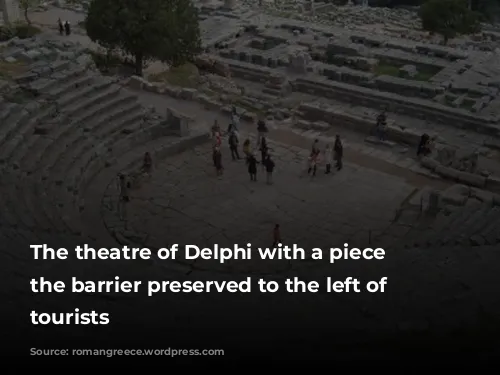(This article explores the intriguing absence of amphitheatres in Greece and the fascinating ways Greeks adapted their existing spaces for gladiatorial combat.)
Have you ever wondered why there are no amphitheatres in Greece? It’s a question that has puzzled many, and one that even prompted a reader to ask me.
Before diving into the answer, I want to give credit where credit is due. A brilliant article by Katherine Welch, a professor at New York University and an expert on Roman amphitheatres, laid the groundwork for much of what I’m about to share.
Roman Influence on Greek Culture
(This section delves into the impact of Roman rule on Greek culture, highlighting the differences in how each society embraced Roman traditions.)
When Rome conquered the northwest regions of Europe, it brought about a profound transformation. Iron Age tribes were absorbed into a sophisticated urban system. People began using Roman coins, buying Roman goods, and even visiting Roman baths.
However, the story of the Greek world under Roman rule is more nuanced. Greeks had already established cities, worshipped similar gods as Romans, and had comparable political and economic systems. Rome itself was heavily influenced by Greek culture – a process known as Hellenization. So, what exactly did change for the Greeks under Roman rule?

Gladiatorial Games in Greece
(This section examines the evidence for gladiatorial combats in Greece and the use of existing structures to accommodate these events.)
Scholars have identified several key markers of Roman influence in Greece: worship of the emperor, the adoption of Roman-style bathhouses, and perhaps most notably, the introduction of gladiatorial games.
Surprisingly, there’s considerable evidence that Greeks did indeed enjoy watching gladiatorial contests. Inscriptions, tombstones, and even a cemetery full of gladiator skeletons in Ephesus, Turkey, all point to this. The question, however, is why there’s no evidence for the amphitheatres that housed these fights in other parts of the Roman Empire.
The answer seems to be that Greeks preferred to adapt existing structures. In Athens, for example, the Theatre of Dionysus was repurposed for gladiatorial combats by adding a waist-high barrier across the orchestra. This barrier wasn’t meant to prevent gladiators from escaping, but rather to safeguard the wealthy spectators seated in the front rows from falling swords and tridents.
A Controversial Transformation
(This section explores the Greek reaction to the adoption of gladiatorial games and the adaptation of sacred spaces for these events.)
This conversion of the Theatre of Dionysus, a sacred space dedicated to the god of theatre and wine, caused considerable controversy. Dio Chrysostom, a Greek author known for his eloquence, expressed disgust at the use of this once-sacred space for such bloody entertainment. His complaint was echoed by Lucian in the 2nd century and Philostratos in the 3rd century.
While some Greeks viewed gladiatorial games as a repugnant Roman tradition, others clearly enjoyed them. The mere presence of such objections implies that there was an audience for these spectacles. The disapproval likely stemmed from a combination of human compassion and a sense of snobbery towards a form of entertainment considered popular among the lower classes.
Beyond the Theatre: Alternative Arenas
(This section discusses the adaptation of other existing structures to host gladiatorial games and the few examples of amphitheatres in the Greek world.)
Other Greek cities followed Athens’ lead in converting existing spaces. A barrier was erected in the theatre at Delphi, and similar adaptations were made at other locations. In Ephesus, the cavea, or seating area, was raised above the orchestra. The most cost-effective option seems to have been to repurpose existing structures.
Later on, stadiums, designed for athletic competitions, were also transformed into amphitheatres. At Messene in the Peloponnese and Aphrodisias in western Turkey, makeshift curved walls were added to the running track to create a suitable arena for gladiatorial combat.
While the majority of Greek cities chose to adapt existing spaces, there are a few examples of actual amphitheatres. These tended to be located in cities with strong Roman influence, such as Gortyn and Knossos on Crete, and Corinth, a city that was re-founded as a Roman colony by Julius Caesar. These amphitheatres were not grand stone structures like the Colosseum, but rather more modest earth-bank constructions.
The Agora as a Potential Arena
(This section explores the possibility of gladiator fights taking place in the agora, the traditional Greek public square.)
Some scholars speculate that gladiator fights may have been held in the agora, the traditional public square in Greek cities. In ancient Rome, gladiatorial games were initially held in the Forum. Vitruvius, a Roman architect writing during the reign of Augustus, recommended that Roman fora should be rectangular to accommodate spectators, unlike Greek agoras which tended to be more square. The Forum of Corinth, built in accordance with Vitruvius’ recommendation, may have been the site of gladiatorial games before the construction of the amphitheatre.
At Hierapolis in Asia Minor, the presence of gladiatorial reliefs on a stoa-basilica lining the agora suggests that this space may also have been used for such spectacles. The stoa’s colonnade could have served as a grandstand, and the monumental entrance might have been reserved for dignitaries. The sculpted lions attacking bulls on the entrance columns may have been a nod to the beast fights that were often staged alongside gladiatorial combat.
The Lasting Impact of Roman Influence
(This section concludes the article by highlighting the lasting influence of gladiatorial games on Greek culture.)
The widespread evidence of gladiatorial games in the Greek world, including the adaptation of existing structures and the presence of gladiator reliefs, underscores the profound impact of Roman culture. The Romans may not have built amphitheatres in every Greek city, but they certainly left their mark on Greek society.
So, there you have it. While Greece may not have been dotted with the iconic amphitheatres found throughout the Roman Empire, the Greeks found their own ways to embrace the thrilling spectacle of gladiatorial games.
